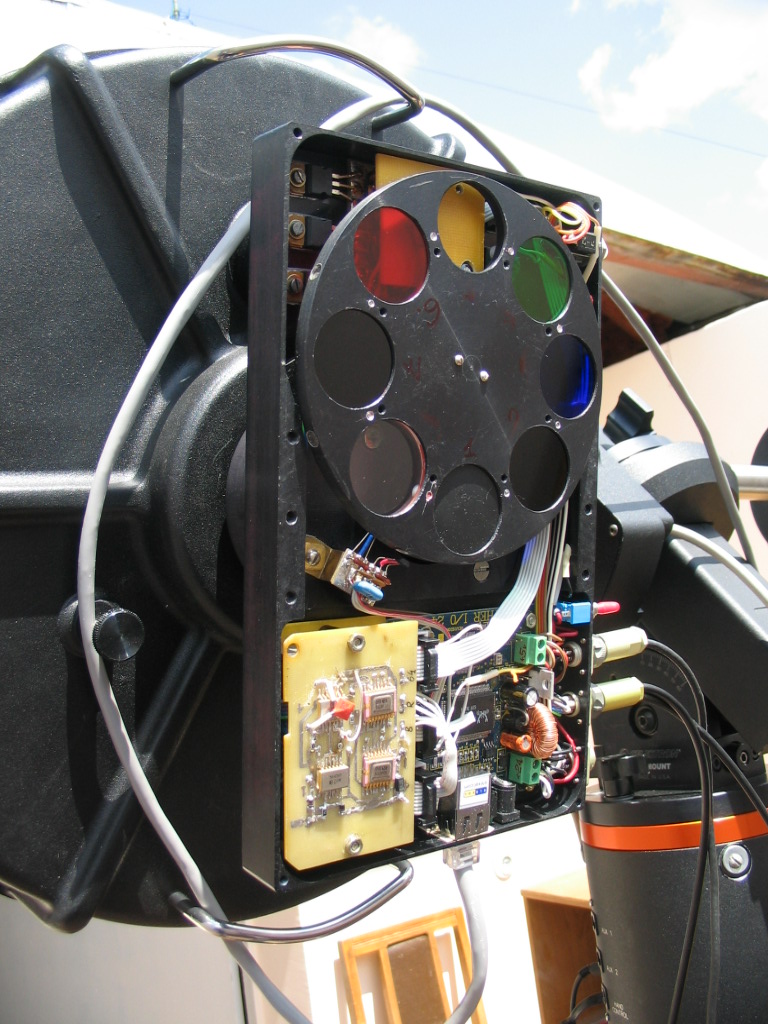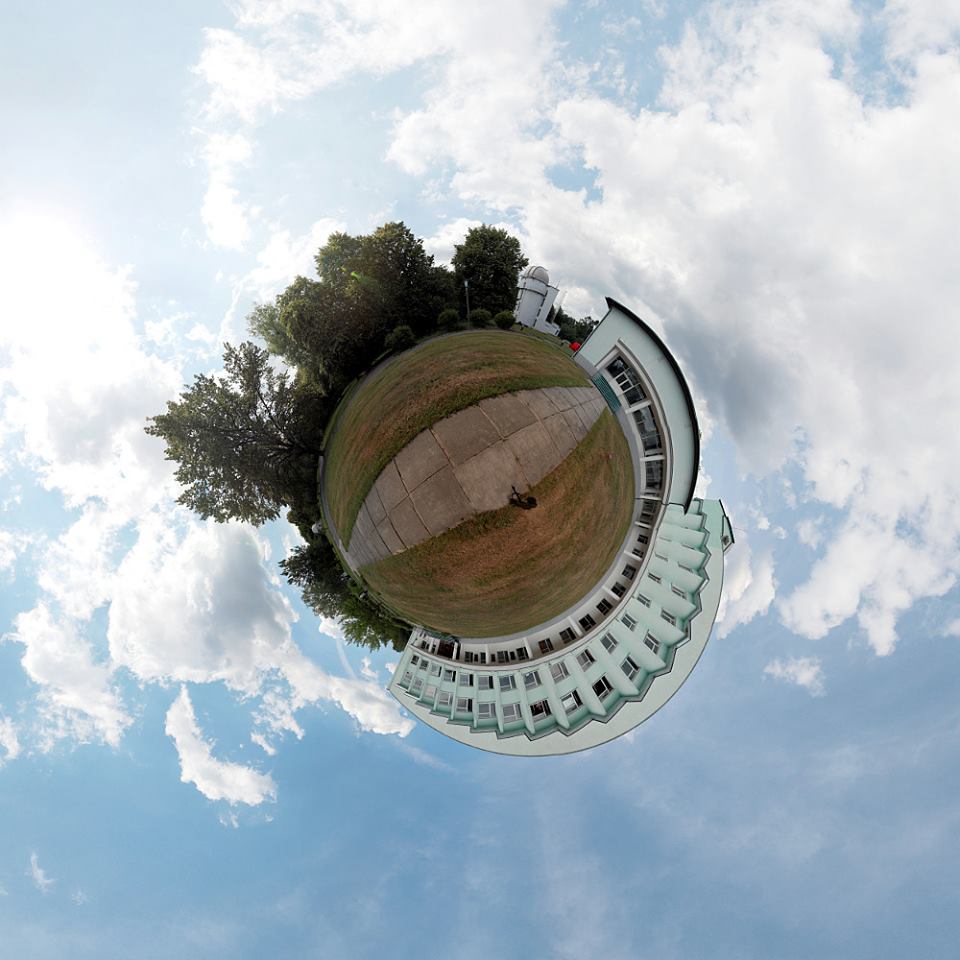Kyiv Internet Telescope
Welcome to the KIT website!
 KIT (Kyiv Internet Telescope) is a joint project driven by the Main Astronomical Observatory of the National Academy of Science of Ukraine (MAO NASU) in close collaboration with the Astronomical Observatory of the Kyiv Taras Shevchenko University of Ministry of Education and Science of Ukraine (AO KNUTS MESU).
KIT (Kyiv Internet Telescope) is a joint project driven by the Main Astronomical Observatory of the National Academy of Science of Ukraine (MAO NASU) in close collaboration with the Astronomical Observatory of the Kyiv Taras Shevchenko University of Ministry of Education and Science of Ukraine (AO KNUTS MESU).
Mostly funded by the Science and Technology Center in Ukraine (STCU) and the National Academy of Science of Ukraine (NASU) with the participation of the AO KNUTS MESU, is devoted to the characterization of planets located outside our solar system (exoplanets) and to the study of comets and other small bodies in our solar system. It consists of a 35cm robotic telescope located at the Lisnyky Observational Station of the AO KNUTS MESU.
You will find on this site information about KIT. Please take the time to visit. If you have any question please feel free to contact us at the email address below.
Contact: This email address is being protected from spambots. You need JavaScript enabled to view it.
Science
Research of the stars with planets which pass apparent star disk (transiting exoplanets).
The transit method based on a detection star brightness decrease during a passing of planet in front of its disk. Observed brightness system decries when planet pass star disk and its volume depend of the relative sizes star and planet. Method allows to determine a planet radius, and orbit period and its inclination what together with method of radial velocity gives us opportunity to calculate planet mass.
International project “The DWARF project: Eclipsing binaries - precise clocks to discover exoplanets”
Observational campaign on the search for planets around of eclipsing binaries systems. Project include network of North hemisphere telescopes with apertures from 25 to 200 cm from more as 20 observatories involved.
Principal investigator of the project are Theodor Pribulla from Astronomical Institute Slovak Academy of Sciences Tatranska Lomnica (http://www.astro.sk/~pribulla/).
Scientific background: system brightness decries when a brighter star shade with another star. Moment of the time of the glow minima is named primary eclipse. The second eclipse has smaller amplitude when the star with a lower brightness pass behind a brighter star. It is usually can be observed too. If there is the planet in this system, stars under this planet gravity will shift relative to the mass centre of the stars-planet system and they will follow along the modified orbit. Therefore minima eclipse moments will vary constantly.
The goal of the project is the research of a displacements periodicity in these minima on a base of exact determination of the moment’s eclipse minima.
Study of cometary activity at large heliocentric distances
Small bodies from the outskirts of the Solar system are considered to be relatively unmodified remnants of the early stage of the solar system formation. Therefore, they can retain information about the abundance of volatile materials in comet progenitors and the local physical conditions at the stage of their origin. Being scattered in the inner region of the Solar System, some of small bodies become considerably active developing as comets at heliocentric distances larger than 4 AU.
This phenomenon cannot be explained by classical theories.There are different hypotheses considering different physical mechanisms, which can trigger physical activity at such large heliocentric distances. The monitoring of dynamically new comets, when they move far from the Sun, can reveal various patterns of the development of the cometary activity and provide data for studying the brightness evolution and dust composition of their coma. Furthermore, this is also a means to discriminate between different physical mechanisms triggering and sustaining the physical activity of comets.
KIT Team
- Yaroslav Romanyuk
Position: Senior Scientist Research, Main Astronomical Observatory of NASU
Functions: Principal Investigator, Project Administrative Manager, Instrument Manager, On Site Technical Support - (exoplanets, eclipsing binaries, comets, asteroids))
E-mail: This email address is being protected from spambots. You need JavaScript enabled to view it. - Valery Kleshchonok
Position:Head of Department AO NKNUTS MESU
Functions:Co-Investigator, Science and Software Manager - (occultation phenomena, asteroids, comets)
E-mail: This email address is being protected from spambots. You need JavaScript enabled to view it. - Victoriia Krushevska
Position: Senior Scientist Research MAO NASU
Functions: Co-Investigator (exoplanets, eclipsing binaries)
E-mail: This email address is being protected from spambots. You need JavaScript enabled to view it. - Yuliana Kuznyetsova
Position: Research Associate MAO NASU
Functions: Co-Investigator (exoplanets)
E-mail: This email address is being protected from spambots. You need JavaScript enabled to view it. - Iryna Kulyk
Position:Senior Scientist Research MAO NASU
Functions: Co-Investigator (comets)
E-mail: This email address is being protected from spambots. You need JavaScript enabled to view it. - Mykola Buromsky
Position:Principal engineer AO KNUTS MESU
Functions: Co-Investigator (occultation phenomena)
E-mail: This email address is being protected from spambots. You need JavaScript enabled to view it.
Acknowledgements
We would like to thank the following persons for the help provided during the setup of the project:
- Oleg Svyatogorov, Victor Karbovskiy, Yuri Ivanov, Myhailo Sosonkin, Myhailo Medvedsky and all staff of the Main Astronomical Observatory of NASU who helped us with telescope development and mounting.
- Zhanna Pishkalo, from Lisnyky Observatory for continuous support.
- Volodymyr Reshetnyk and Andrew Simon and Ivan Hatko for test observations.
- Sergii and Andrii Verbytsky from White Swan Co for equipment and its support.
We also give a special thanks to the whole MAO NASU and Lisnyky Observatory staff for their constant help and support!
Former Collaborators : Oleksandr Sergyeyev, Mykola Karpov, Vira Godunova, Maxym Andreev from International Center for Astronomical, Medical and Ecological Research of National Academy of Science of Ukraine ICAMER NASU), Igor Luk'yanyk, Volodymyr Reshetnyk, Vasyl Danylevsky, Vasyl Ivchenko, Viktor Lapchuk from AO KNUTS MESU, Oleg Svyatogorov, Borys Zhilyaev, Irina Verlyuk from MAO NASU - were participants of the Project “The Ukrainian synchronous Network of Internet Telescopes” (UNIT) during which KIT was developed.
Equipment
- KIT: optical tube
Model: Celestron 1400 XLT Type: Shmidt-Cassegrain Material: aluminium Diameter: 355 mm (14 inch) System focal ratio: F/11 Focusing system: main mirror move Weight: 20.4 kg - The mount
Model: WS240GT Type: German equatorial Motors: Brush Commutated DC Motors Speed: up to 10 deg/sec Pointing accuracy (with
pointing model):1.7 arcmin Weight: 48 kg - Camera 1
Model: QImaging Rolera MGi CCD: CCD97 Array size: 512 x 512 pixels CCD type: back-illuminated Pixel size: 16 microns Pixel scale: 0.844 arcsec/pixels Field of view: 8.55 x 8.55 arcmin Full well: 240,000e- (1x1); 800,000e- (2x2, non-EM mode) Read-out noise: <1 e- rms in EM mode Readout Frequency: 10, 5MHz (EM mode); 5, 1MHz (normal mode) Dark current: 0.5 e-/pix/s Digital Output: 14 bits Cooling: -25°C below ambient Weight: 3.18 kg - Camera 2
Model: SBIG ST-8XME CCD: KAF-1603ME Array size: 1530x1020 pixels (13.8 x 9.2 mm) Pixel size: 9 microns Pixel scale: 0.475 arcsec/pixels Field of view: 12.1x7.65 arcmin Full well: 100,000 electrons Gain: 1.5 el/ADU Peak QE: 85% at 650 nm Read-out noise: 17e. RMS electrons Read-out time: ~2 seconds with USB 2.0 Dark current: 1e./pixel/sec at 0° C Cooling: -35°C below ambient Temperature stability: 0.1°C Weight: 0.6kg - The filter wheel

Model: Own design Filter type: diameter 32 mm filters Max. filter thickness: 7 mm Weight: 1.3 kg (1wheel with 8 filters) Filters (wheel 1): Johnson/Cousins BVRcIc U Electronic: Controller for Filters and Autofocus - Software
Operating system: Microsoft Windows XP Pro Observation schedule: CCENTER (own development) Telescope control: Telescope (own development) Camera control: QCam (own development) Filter wheel control: Filters (own development) Focus control: Autofocus (own development) Plate solving: Platesolvexp Standard driver: ASCOM
Contact: This email address is being protected from spambots. You need JavaScript enabled to view it.
Site
Lisnyky Observational Station of the AO KNUTS MESU located in the village Lisnyky, at an altitude of 143 m a.s.l. and 7 km out of South border of Kyiv. There are some 70-85 clear nights per year.
KIT Coordinates:
| Latitude : | 50° 17' 53 (N) 50,2970 (N) |
| Longtitude: | 30° 31' 27 (E) 30,4978 (E) |
| Altitude: | 143 m a.s.l. |



 COORDINATES
COORDINATES